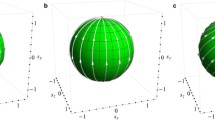Abstract
The development of efficient time optimal control strategies for coupled spin systems plays a fundamental role in nuclear magnetic resonance (NMR) spectroscopy. In particular, one of the major challenges lies in steering a given spin system to a maximum of its so-called transfer function. In this paper we study in detail these questions for a system of two weakly coupled spin-½ particles. First, we determine the set of maxima of the transfer function on the special unitary group SU(4). It is shown that the set of maxima decomposes into two connected components and an explicit description of both components is derived. Related characterizations for the restricted optimization task on the special orthogonal group SO(4) are obtained as well. In the second part, some general results on time optimal control on compact Lie groups are re-inspected. As an application of these results it is shown that each maximum of the transfer function can be reached in the same optimal time. Moreover, a global optimization algorithm is presented to explicitly construct time optimal controls for bilinear systems evolving on compact Lie groups. The algorithm is based on Lie-theoretic time optimal control results, established in [15], as well as on a recently proposed hybrid optimization method. Numerical simulations show that the algorithm performs well in the case a two spin-½ system.
Similar content being viewed by others
References
Agrachev, A. and Sachkov, Y. (2004), Control Theory from the Geometric Viewpoint, Springer Verlag, Berlin.
F. Albertini D. D’Alessandro (2003) ArticleTitleNotions of Controllability for Bilinear Multilevel Quantum Systems IEEE Transactions on Automatic Control 48 IssueID8 1399–1403 Occurrence Handle10.1109/TAC.2003.815027
D. D’Alessandro (2003) ArticleTitleControllability of one spin and two interacting spins Mathematics Control Signals Systems (1994) 16 1–25
Ando, T. and Li, C.-K. (eds.), Special Issue: The Numerical Range and Numerical Radius of Linear and Multilinear Algebra 37(1–3), 1–238, Gordon and Breach.
A.M. Bloch R.W. Brockett T.S. Ratiu (1992) ArticleTitleCompletely integrable gradient flows Communications in Mathematical Physics 147 57–74 Occurrence Handle10.1007/BF02099528
Brockett, R.W. (1990), Some Mathematical Aspects of Robotics. In: Robotics, Proceedings of Symposia in Applied Mathematics, Vol. 41, AMS, Providence.
S.J. Glaser T. Schulte-Herbrüggen M. Sieveking O. Schedletzky N.C. Nielsen O.W. Sørensen C. Griesinger (1998) ArticleTitleUnitary control in quantum ensembles: Maximizing signal intensity in coherent spectroscopy Science 280 421–424 Occurrence Handle10.1126/science.280.5362.421
Ernst, R.R., Bodenhausen, G. and Wokaun, A. (1987), Principles of Nuclear Magnetic Resonance in One and Two Dimensions, Oxford University Press, New York.
Goodman, R. and Wallach, N.R. (1998), Representations and Invariants of the Classical Groups, Cambridge University Press.
Hammerer, K., Vidal, G. and Cirac, J.I. (2002), Characterization of nonlocal gates, Physical Review A 66, 062321.
U. Helmke K. Hüper J.B. Moore Th. Schulte-Herbrüggen (2002) ArticleTitleGradient flows computing the C-numerical range with applications in NMR spectroscopy Journal of Global Optimization 23 IssueID3–4 283–308 Occurrence Handle10.1023/A:1016582714251
S. Helgason (1978) Differential Geometry, Lie Groups, and Symmetric Spaces Academic Press San Diego
U. Helmke J.B. Moore (1994) Optimization and Dynamical Systems Springer London
V. Jurdjevic (1997) Geometric Control Theory Cambridge University Press New York
Khaneja, N., Brockett, R. and Glaser, S.J. (2001), Time optimal control in spin systems, Physical Review A, 63(3)/032308.
Khaneja, N., Glaser, S. and Brockett, R. (2002), Sub-Riemannian geometry and time optimal control of three spin systems: Quantum gates and coherence transfer, Physical Review A, 65(3)/032301.
N. Khaneja S. Glaser (2001) ArticleTitleCartan decomposition of SU(2n) and control of spin systems Chemical Physics 267 11–23 Occurrence Handle10.1016/S0301-0104(01)00318-4
Knapp, A.W. (2002). Lie Groups Beyond an Introduction, Second Edition. Birkhäuser, Boston.
Schulte-Herbrüggen, T. (1998), Aspects and Prospects of High-Resolution NMR. PhD thesis, ETH Zürich. Dissertation ETH No. 12752.
C. Yiu Y. Liu K.L. Teo (2004) ArticleTitleA hybrid decent method for global optimization Journal of Global Optimization 28 IssueID2 229–238 Occurrence Handle10.1023/B:JOGO.0000015313.93974.b0
J. Zabczyk (1992) Mathematical Control Theory: An Introduction Birkhäuser Boston
Author information
Authors and Affiliations
Corresponding author
Rights and permissions
About this article
Cite this article
Dirr, G., helmke, U., Hüper, K. et al. Spin Dynamics: A Paradigm for Time Optimal Control on Compact Lie Groups. J Glob Optim 35, 443–474 (2006). https://doi.org/10.1007/s10898-005-6015-6
Received:
Accepted:
Issue Date:
DOI: https://doi.org/10.1007/s10898-005-6015-6




